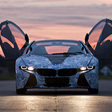You can login to your account or create a new account.
You can login to your account or create a new account.
You can login to your account or create a new account.
The concept study BMW Vision EfficientDynamics is a representation of what the pleasure of driving will be in the future according to the German brand. Since its presentation at the Frankfurt International Motor Show IAA in 2009, the vehicle has received several awards both for its futuristic design and its engine technology.
The car is just 1.24 metres high and brings the shaping style from BMW towards the aesthetic appeal and dynamic performance. The car has wing doors that facilitate entry to both rows of seats and a drag coefficient of 0.22, result of extensive aerodynamic work in its development. The Vision EfficientDynamics is powered by a combination of a 3-cylinder turbo diesel with a hybrid synchronous motor at the front axle and a full-hybrid engine at the rear axle. The result is an overall system output of 241 kW/328 bhp. The BMW ActiveHybrid technology enables the concept car to have performance levels of a sports car, requiring 4.8 seconds to accelerate from 0 to 100 km/h. It has an average fuel consumption in the EU test cycle of 3.76 litters/100 kilometers, which represents CO2 emissions of 99 grams per kilometer.
At the Leipzig trade fair centre BMW presented a fully road-ready technology showcase vehicle based on the BMW Vision EfficientDynamics concept study. In 2010 the brand confirmed rumours that stated that a production model of the Vision EfficientDynamics had received greenlight.
BMW
Since its first steps on vehicle building, BMW has committed itself to advanced technology and constant improvement. The Germany-based pioneers were the experienced aviator Gustav Otto and the owner of Rapp Motorenwerke (an aircraft engine factory), Karl Rapp. These men combined efforts in order to start a real aircraft industry, placed in Munich, which would serve the German military during the First World War by providing them the airplanes. So, in 1913,... more






